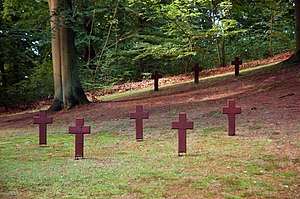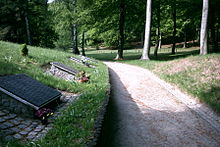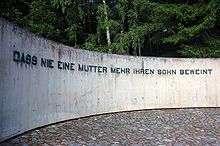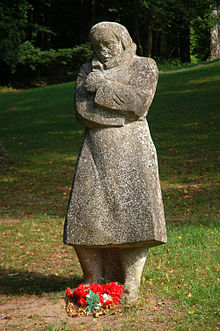Golm (Usedom)
| Golm | ||
|---|---|---|
|
War cemetery on the Golm |
||
| height | 69 m | |
| location | Usedom , Mecklenburg-Western Pomerania , Germany | |
| Coordinates | 53 ° 53 '10 " N , 14 ° 12' 17" E | |
|
|
||
| particularities | Highest point on the island of Usedom | |
The Golm is with a height of 69 meters, the highest point on the island of Usedom in the east of the country Mecklenburg-Vorpommern . It is located in the eastern part of the island in the municipality of Garz near the village of Kamminke close to the German-Polish border . The Golm and about 25 hectares of its immediate surroundings have been under nature protection since 1967 . The name is derived from a Slavic word for hill .
During the Second World War , between 6,000 and 14,000 victims were buried in mass graves on the Golm after the American air raid on nearby Swinoujscie on March 12, 1945; most of which were after the start of the battle for East Prussia before the Red Army from the province of East Prussia fled. Before that, the place was used as a military cemetery . Since then, the Golm has been one of the largest war cemeteries in Germany and the largest memorial of its kind in Mecklenburg-Western Pomerania. The site is equipped with appropriate commemorative and documentation facilities and is visited by around 30,000 to 40,000 people annually.
Natural history and prehistoric information
The Golm was formed as part of a terminal moraine when the glacier ice melted in the Oder estuary and was compressed by later ice advances. Until about 5,000 years ago, the mountain was still washed by the Baltic Sea , only later was it gradually cut off from the sea. In 1860 a stone ax and a cup were discovered during forest work, and in 1892 evidence of a Bronze Age castle wall was found on the Golm. Young bronze to early Iron Age castle wall with the field name "der Golm". As one of its northern branches, the well-preserved castle wall represents the influence of the Lusatian culture. Overall, it is in good condition, but shows damage from the Second World War. There a flak position was built on the site of the former restaurant, as this is the lookout point of Swinoujscie. In front of the castle wall there is a Landwehr and several Bronze Age barrows to the southeast.
The area around the Golm is characterized by an extensive beech forest with corresponding flora and fauna . For example, broods of peregrine falcons , sea eagles , honey buzzards , hoopoes and rough owls have been detected on the Golm and its surroundings . After 1990 the eagle owl was also reintroduced. The plants to be found here include fescue grasses , St. Christopher's herb and the onion-bearing tooth root . The Golm and its immediate surroundings have been a nature reserve since 1967 .
The springs on the northern slope of the Golm were used by a company from Swinoujscie to produce mineral water until the Second World War .
Recent history of the place
From around the middle of the 19th century, the Golm was a popular destination for the residents of the nearby city of Swinoujscie , which today belongs to Poland . As a result, corresponding gastronomic facilities were built in its vicinity, such as a restaurant called "Onkel Thoms Hütte", a lookout tower and memorials for those who died in the wars of that time. In 1852 the Golm was made accessible by a paved road, in 1880 a train stop was built on the railway line from Swinoujscie to Berlin .
Golm war cemetery
During the Second World War, the Golm began to be used as a military cemetery under the name Swinoujscie-Golm cemetery of honor . First soldiers of the naval units stationed in Swinoujscie were buried , including 51 crew members of the submarine U 854, which sank north of Swinoujscie on February 4, 1944, and other warships. In addition to the naval cemetery, burial sites were created a short time later for soldiers of the army who had died in the Swinoujscie hospital or on transports with hospital ships. Air force members of the nearby Garz Air Base also found their final resting place here. Around 3,000 to 4,000 soldiers are said to have been buried on the Golm
In the midday of March 12, 1945, there was an American bombing raid on the city of Swinoujscie , in which more than 100,000 people were staying at that time due to the influx of refugees. Around 5,000 (up to 20,000) of them lost their lives in this attack. The many unidentifiable dead were buried anonymously in mass graves on the Golm ("Cemetery of the Unknowns"); the names of only 432 were known. These received individual burials in terraced row graves. The memorial service took place on March 25, 1945, District Administrator Flörke gave a speech. The names of 237 other people buried on the Golm could be determined through research after 1990. Four memorial plaques were dedicated to them.
On March 12, 1992 the community of interests Gedenkstätte Golm e. V. founded. The aim of the association was the commitment to the preservation and dignified design of the war victims cemetery. The Volksbund Deutsche Kriegsgräberfürsorge has been the sponsor of the memorial since March 2000 and carries out the associated tasks. On March 13, 2005 the Volksbund opened an international youth meeting place in the former Kamminker village school. With the design of the memorial after 1990, the assumption of sponsorship by the Volksbund and the continuation of its work by the youth meeting center, the community of interests saw its statutory tasks as successfully fulfilled and decided to dissolve it on Memorial Day 2005.
Reminder and memorial
Immediately after the war, various efforts by church and private parties to design the site, which was state-owned, failed. By 1950 the plant was already partially overgrown. Individual graves with victims of the air raids were initially respected, but the area of the mass graves as well as the naval and military cemeteries were subjected to "forestry use" with the construction of pine trees. In 1955 the mass graves had already disappeared. A 13 meter high wooden cross erected on April 9, 1954 on the highest point of the Golm was destroyed by "unknown perpetrators" on the night of Wednesday April 14th, 1954. The request for rebuilding was denied. The statue “The Freezing Woman in a Soldier's Coat”, created by the Bansin sculptor Rudolf Leptien in 1952, was never even erected. Officials said: “The unfinished sculpture says little.” Leptien fled to West Berlin . The Golm came under the responsibility of the Wolgast District Council, which had to take care of the maintenance of the facility. The communist Richard Döring from Kamminke was among the gardeners. At his endeavor, the sculpture was erected in the intended place in 1984 without the approval of the authorities. In 1967, under the direction of the church, a number of granite crosses and nameplates were erected on the part of the cemetery with the graves of bomb victims. In 1969 these were cleared away and any "individual grave design" was canceled
In 1968 the Rostock sculptor Wolfgang Eckardt was commissioned to build a “memorial against war and fascism”. Following his suggestions, the four previously separate cemeteries were creatively united by appropriate lawns. At a central point on the mountain, a two-part circular building made of concrete with a diameter of several meters was built, which was structurally completed in 1973 but never completed. This is accessible and bears the inscription "TWENTY-THREE THOUSAND THOUSANDS OF WORLD WAR II DEAD" on a central, round, metal base plate as well as the inscription "That no mother weeps for her son again" on the inside of the concrete wall. A planned relief was dispensed with for both financial and artistic reasons. The inscription was forcibly removed by strangers on September 3, 2009. The Volksbund then had new, bronze-colored plastic letters attached in February 2010. These were also removed on June 27, 2010 by previously unknown perpetrators. It was similar with the nameplates - they too were stolen and replaced by plastic sheets with a silver foil that were of no interest to non-ferrous metal thieves.
From 1995 the design of the site was supplemented by additional elements. Various granite and wood crosses as well as bronze plaques with the well-known names of the dead buried here were set up around the rotunda. In addition, a showcase was erected at the beginning of the entrance to the memorial, as well as an information building with information on the history of the site.
A granite stele at the access path bears a plaque with the following inscription: "THE GOLM ONE POPULAR EXCURSION DESTINATION NOW REST OF MANY THOUSAND VICTIMS OF THE BOMB ATTACK ON MARCH 12, 1945 ON SWINEMÜNDE. BUT DON'T FORGET - WE REMEMBER THE DEAD". THE HOME COMMUNITY OF THE SWINEMÜNDER. MARCH 12, 1995. TABLE REVEALS 2010 ". The original text from 1995 read:" THE GOLM ONE POPULAR EXCURSION DESTINATION NOW REST OF MORE THAN 20,000 VICTIMS OF THE BOMB ATTACK ON SWINEMÜNDE. A CITY OF SANK IN TROUBLE. FORGIVING BUT DON'T FORGET. WE REMEMBER THE DEAD. THE HOME COMMUNITY OF THE SWINEMÜNDER. MARCH 12, 1995 "
The inscription on a floor plaque reads: "WE REMEMBER THE MANY UNKNOWN DEAD WHO CAME TO LIFE IN SWINEMÜNDE ON MARCH 12, 1945, AND WERE DIVIDED HERE INTO COLLECTIVE GRADES OF THE EARTH. TAKE CARE OF WHO YOU ARE STILL LIVING ALSO THE SOLDIERS, REFUGEES AND RESIDENTS OF THE CITY OF SWINEMÜNDE, WHO FOUND IN THE BOMB ATTACK ON MARCH 12, 1945 AND ARE BURIED UNDER THE Wreckage OF THE CITY.
The number of war victims on the Golm is controversial. By the beginning of the new millennium, there was broad consensus that around 23,000 dead lay there: 20,000 bomb deaths and 3,000 soldiers
Along with the Halbe forest cemetery in the state of Brandenburg , where around 28,000 victims of the Second World War were buried, the Golm is one of the largest war cemeteries in Germany. The number of visitors is around 30,000 to 40,000 people per year. Annually on March 12th and on the day of national mourning there are commemorative events on the Golm. The youth meeting and educational center Golm in Kamminke was awarded a hiking nail cross from Coventry in 2009 , which will later probably be taken over by the Catholic parish of Stella Maris in Swinoujscie .
See also
literature
- Norbert Buske: The cross on the Golm. Politically owned war graves . State Center for Political Education Mecklenburg-Western Pomerania. Regional studies booklets. Schwerin, Helms-Verlag 1995. ISBN 3-931185-01-X
- Interest group Gedenkstätte Golm e. V. (Ed.): The Golm on Usedom. Baltic Verlag, Greifswald 1996.
- Golm memorial. In: Martin Kaule: Ostseeküste 1933–1945. The historical travel guide. License issue for the state center for political education Mecklenburg-Western Pomerania. Christoph Links Verlag, Berlin 2009, ISBN 3-86153-521-1 , p. 111.
- Volksbund Deutsche Kriegsgräberfürsorge e. V. (Hrsg.): Golm war cemetery: learning place of history. Helms, Schwerin 2003, ISBN 3-935749-26-0 .
- Volksbund Deutsche Kriegsgräberfürsorge e. V. (Ed.): The Golm and the tragedy of Swinoujscie. War graves as a signpost between the past and the future. nordlicht verlag, Kamminke 2010, ISBN 978-3-9809640-6-7 .
Web links
- Literature about Golm (Usedom) in the state bibliography MV
- The Golm on Usedom
- Website of the Volksbund Deutsche Kriegsgräberfürsorge for the Golm war cemetery
- Youth meeting place Golm
- The planned inferno, Der Spiegel April 1, 2003
Individual evidence
- ↑ Garz village church map
- ^ Letter from the Rostock District Council of July 18, 1954 to the Wolgast District Council: Sculpture for the Golm cemetery , a copy is posted in the information pavilion on the Golm
- ↑ Norbert Buske: The cross on the Golm. Politically owned war graves . State center for political education. Schwerin, 1995
- ↑ With these words ends the second stanza of the GDR national anthem .
- ↑ https://www.denkmalprojekt.org/2010/golm_usedom_Soldaten_wk2_mvp.htm
- ↑ Christa Drews von Steindorff (director of the State Center for Political Education, Schwerin) in Norbert Buske: The Cross on the Golm . Schwerin, 1995
- ^ Ingeborg Simon, Golm leaflet, published by IG Gedenkstätte Golm
- ↑ Deutschlandfunk Kultur 2005. The dead on the Golm. https://www.deutschlandfunkkultur.de/die-toten-auf-dem-golm.1134.de.html
- ↑ Online project Memorials to Fallen. By genealogists for genealogists. 2010 https://www.denkmalprojekt.org/2010/golm_usedom_Soldaten_wk2_mvp.htm
- ↑ Base plate on the central Golm monument















